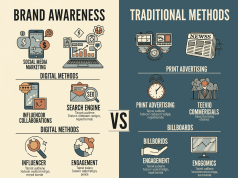In an age where innovation moves at lightning speed, staying ahead in the marketing technology (martech) landscape is crucial for businesses aiming to engage consumers effectively and maintain a competitive edge. As brands increasingly rely on technology to streamline operations and enhance customer experiences, understanding emerging trends in the martech ecosystem is essential. Here are some key developments shaping the future of marketing technology.
1. Personalization at Scale
Personalization is no longer a luxury; it’s a necessity. With advancements in data analytics and machine learning, marketers are now more equipped than ever to deliver personalized experiences at scale. Companies are utilizing AI-driven algorithms to analyze consumer behavior, preferences, and demographics, allowing them to tailor their messaging and marketing strategies. This shift not only increases engagement but also fosters brand loyalty.
Example:
Brands like Amazon and Netflix have successfully implemented algorithms that curate product recommendations based on users’ past behavior, demonstrating the power of personalized content.
2. Artificial Intelligence and Machine Learning
Artificial Intelligence (AI) is transforming how marketers operate. From chatbots providing 24/7 customer service to predictive analytics forecasting customer trends, AI is paving the way for more efficient marketing strategies. Machine learning algorithms can analyze vast datasets to identify patterns, enabling companies to make data-driven decisions without human intervention.
Example:
AI-powered tools like Salesforce’s Einstein and HubSpot’s Marketing Hub are increasingly used to optimize campaigns, providing insights that lead to better targeting and higher conversion rates.
3. Integration of Marketing and Sales
The alignment between marketing and sales teams is becoming more integrated, thanks to shared technology platforms. Customer Relationship Management (CRM) systems enable seamless communication between marketing campaigns and sales engagement. This integration not only improves lead tracking but also allows for a more cohesive customer experience.
Example:
Platforms like HubSpot and Marketo offer features that facilitate collaboration between marketing and sales teams, ensuring that strategies align and sales processes benefit from marketing insights.
4. Omnichannel Marketing
As consumers interact with brands across various platforms, omnichannel marketing has emerged as a critical strategy. This approach ensures that customers have a consistent experience, whether they are shopping online, browsing social media, or visiting a physical store. Marketing technology enables brands to track customer interactions across channels, helping to create personalized experiences regardless of where the consumer engages with the brand.
Example:
Retailers like Target and Walmart utilize integrated platforms to manage their online and offline interactions, thus enhancing customer experience through seamless transitions across channels.
5. Privacy and Data Security
With the rise of data privacy regulations such as GDPR and CCPA, marketers must prioritize data security while still delivering targeted campaigns. As consumers become more aware of their data rights, transparency and ethical data usage have become paramount. Marketing technologies are evolving to ensure compliance with regulations while enabling effective data usage.
Example:
Companies like TrustArc offer solutions to help organizations manage compliance with data privacy laws, ensuring that marketers can operate effectively without risking consumer trust.
6. Voice Search and Conversational Marketing
The proliferation of voice-activated devices has led to an uptick in voice search. Marketers are now adapting to this trend by optimizing their content for voice queries and leveraging conversational marketing through chatbots and voice assistants. This shift enhances user experience and allows brands to engage customers in real-time.
Example:
Brands like Domino’s have pioneered voice-activated pizza ordering systems, allowing customers to easily place orders through devices like Amazon Alexa.
7. Augmented Reality (AR) and Virtual Reality (VR)
AR and VR are revolutionizing how brands engage their audiences. These technologies enable interactive experiences that allow consumers to visualize products before purchasing. In e-commerce, for instance, AR can help customers see how a piece of furniture would look in their home, ultimately influencing their buying decision.
Example:
IKEA’s AR app allows users to place virtual furniture in their real-world environments, creating an engaging shopping experience that enhances consumer confidence.
Conclusion
The martech landscape is evolving rapidly, driven by technological advancements and changing consumer expectations. By embracing these trends—personalization, AI integration, omnichannel strategies, and more—marketers can stay ahead of the curve. As they adapt to these innovations, businesses will be better positioned to engage customers authentically and effectively, fostering loyalty and driving growth in an increasingly competitive market. Staying informed and agile in this dynamic environment is not just beneficial; it’s essential for future success.









